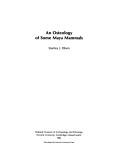| Listing 1 - 5 of 5 |
Sort by
|
Book
ISBN: 9630502518 Year: 1974 Publisher: Budapest : Akadémiai Kiadó,
Abstract | Keywords | Export | Availability | Bookmark
 Loading...
Loading...Choose an application
- Reference Manager
- EndNote
- RefWorks (Direct export to RefWorks)
Domestic animals --- Mammal remains (Archaeology) --- History. --- Mammalian remains (Archaeology) --- Mammals in archaeology --- Animal husbandry --- Barnyard animals --- Beasts --- Domesticated animals --- Farm animals --- History --- Animal remains (Archaeology) --- Archaeology --- Animals --- Zoology, Economic --- Domestication --- Feral animals --- Methodology
Book
ISBN: 9780198749233 0198749236 Year: 2018 Publisher: Oxford : Oxford University Press,
Abstract | Keywords | Export | Availability | Bookmark
 Loading...
Loading...Choose an application
- Reference Manager
- EndNote
- RefWorks (Direct export to RefWorks)
Donkeys carried Christ into Jerusalem while in Greek myth they transported Hephaistos up to Mount Olympos and Dionysos into battle against the Giants. They were probably the first animals that people ever rode, as well as the first used on a large-scale as beasts of burden. Associated with kingship and the gods in the ancient Near East, they have been (and in many places still are) a core technology for moving people and goods over both short and long distances, as well as a supplier of muscle power for threshing and grinding grain, pressing olives, raising water, ploughing fields, and pulling carts, to name just a few of the uses to which they have been put. Yet despite this, they remain one of the least studied, and most widely ignored, of all domestic animals, consigned to the margins of history like so many of those who still depend upon them. Spanning the globe and extending from the donkey's initial domestication up to the present, this book seeks to remedy this situation by using archaeological evidence, in combination with insights from history and anthropology, to resituate the donkey (and its hybrid offspring such as the mule) in the unfolding of human history, looking not just at what donkeys and mules did, but also at how people have thought about and understood them.
Donkeys --- Mules --- Mammal remains (Archaeology) --- Mammalian remains (Archaeology) --- Mammals in archaeology --- Animal remains (Archaeology) --- Archaeology --- Livestock --- Horses --- Ass, Small --- Burros --- Domestic ass --- Equus africanus asinus --- Equus asinus asinus --- African wild ass --- Equus --- Hinnies --- History --- Methodology

ISBN: 0873651995 9780873651998 Year: 1982 Publisher: Cambridge, Mass. : Peabody Museum of Archaeology and Ethnology, Harvard University,
Abstract | Keywords | Export | Availability | Bookmark
 Loading...
Loading...Choose an application
- Reference Manager
- EndNote
- RefWorks (Direct export to RefWorks)
Mayas --- Mammal remains (Archaeology) --- Indians of Mexico --- Indians of Central America --- Indiens d'Amérique --- Antiquities. --- Antiquités --- Mexico --- Central America --- Mexique --- Amérique centrale --- Mammalian remains (Archaeology) --- Mammals in archaeology --- Animal remains (Archaeology) --- Archaeology --- Methodology --- Antiquities --- Indiens d'Amérique --- Antiquités --- Amérique centrale
Book
ISBN: 0860546780 Year: 1989 Volume: 533
Abstract | Keywords | Export | Availability | Bookmark
 Loading...
Loading...Choose an application
- Reference Manager
- EndNote
- RefWorks (Direct export to RefWorks)
Mammal remains (Archaeology) --- Mammals --- Domestic animals --- Restes de mammifères (Archéologie) --- Mammifères --- Animaux domestiques --- Identification. --- Identification --- Animal remains (Archaeology) --- -Eutheria --- Mammalia --- Mammalians --- Prototheria --- Theria --- Vertebrates --- Archaeozoology --- Zooarchaeology --- Zoology in archaeology --- Archaeology --- Bones --- Animal paleopathology --- Methodology --- -Identification --- Mammal remains (Archaeology). --- Restes de mammifères (Archéologie) --- Mammifères --- Animal husbandry --- Barnyard animals --- Beasts --- Domesticated animals --- Farm animals --- Animals --- Zoology, Economic --- Domestication --- Feral animals --- Mammalian remains (Archaeology) --- Mammals in archaeology
Book
ISBN: 9789462980808 9462980802 9789048530281 9048530288 Year: 2016 Publisher: Amsterdam : Amsterdam University Press,
Abstract | Keywords | Export | Availability | Bookmark
 Loading...
Loading...Choose an application
- Reference Manager
- EndNote
- RefWorks (Direct export to RefWorks)
The civitas Batavorum was a settlement on the north-western frontier of the Roman Empire, and it is now the site of numerous archaeological excavations. This book offers the most up-to-date look yet at what has been discovered, using the newest archaeological techniques, about the town and its economy, its military importance, and the religious and domestic buildings it held. It will be essential reading for anyone studying the economy of the Roman provincial countryside or the details of food supply for the Roman army and town.
Excavations (Archaeology) --- Animal remains (Archaeology) --- Romans --- Fouilles (Archéologie) --- Restes d'animaux (Archéologie) --- Romains --- Domestic animals --- Food --- Animaux domestiques --- Alimentation --- Iron age --- Mammal remains (Archaeology) --- Animal culture --- Livestock --- Batavi (Germanic people) --- History. --- Commerce. --- Rhine-Meuse Delta (Netherlands) --- Netherlands --- Antiquities. --- Ethnology --- Italic peoples --- Latini (Italic people) --- Batavians --- Germanic peoples --- Animal husbandry --- Farm animals --- Live stock --- Stock (Animals) --- Stock and stock-breeding --- Agriculture --- Animal industry --- Food animals --- Herders --- Range management --- Rangelands --- Husbandry, Animal --- Zoology, Economic --- Mammalian remains (Archaeology) --- Mammals in archaeology --- Archaeology --- Civilization --- Methodology --- Meuse-Rhine Delta (Netherlands) --- Meuse River Delta (Netherlands) --- Rhine River --- Rhine River Delta (Netherlands) --- Delta --- Roman archaeology, zooarchaeology, animal husbandry.
| Listing 1 - 5 of 5 |
Sort by
|

 Search
Search Feedback
Feedback About UniCat
About UniCat  Help
Help News
News